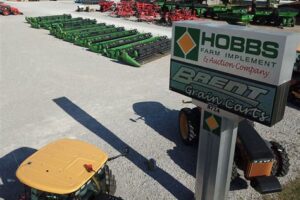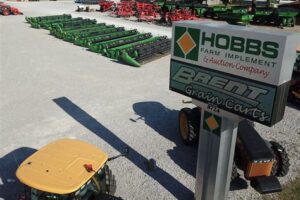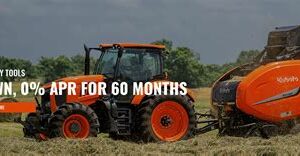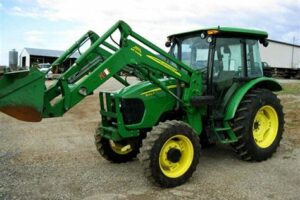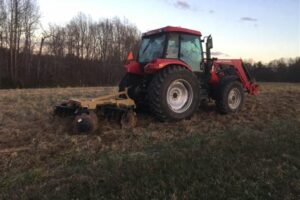Table of Contents
Looking for farm equipment and machinery? Discover a comprehensive list of farm machinery with names. From tractors to harvesters, find the right tools to maximize your farming operations. Explore our extensive collection and make an informed decision for your agricultural needs.
Farm equipment and machinery are the backbone of modern agriculture, revolutionizing the way we cultivate crops and raise livestock. From tractors that effortlessly plow through fields to advanced harvesters that efficiently gather crops, these mechanical marvels have become indispensable tools for farmers around the world. With their impressive array of features and functionalities, farm equipment and machinery ensure optimum efficiency, productivity, and sustainability in agricultural practices. In this article, we will explore some of the most essential and acclaimed farm equipment and machinery, shedding light on their names, capabilities, and contributions to the farming industry.
The Importance of Farm Equipment and Machinery
Farm equipment and machinery play a vital role in modern agriculture, revolutionizing the way farmers cultivate crops and raise livestock. These tools not only increase productivity but also enhance efficiency, allowing farmers to meet the growing demands for food production. With advancements in technology, farm equipment has become more sophisticated, enabling farmers to perform tasks more effectively and sustainably.
1. Tractor
The tractor is perhaps the most iconic piece of farm machinery. It is a powerful vehicle used for various agricultural tasks, such as plowing, tilling, planting, and harvesting. Equipped with large rear wheels and a hydraulic system, tractors provide the necessary power and control to efficiently perform these tasks. They come in different sizes and horsepower ratings to suit the specific needs of each farm operation.
2. Combine Harvester
A combine harvester, commonly known as a combine, is a versatile machine used to harvest grain crops, including wheat, corn, and soybeans. It combines the functions of cutting, threshing, and cleaning the crop in a single pass. This saves significant time and labor compared to traditional harvesting methods. Combines are equipped with a header at the front that cuts the crop and a grain tank at the rear to store the harvested grain.
3. Seeder
A seeder, also known as a planter, is used to sow seeds in the field. It ensures precise seed placement and optimal spacing, resulting in uniform plant growth. Seeders can be either manual or mechanical, with mechanical seeders being more common today. These machines often come with advanced features such as variable seed rates, GPS guidance systems, and automatic row shut-offs, enhancing accuracy and efficiency.
4. Sprayer
Sprayers are essential farm equipment used to apply fertilizers, pesticides, and herbicides to crops. They come in various types, including boom sprayers, airblast sprayers, and mist blowers. Sprayers ensure even and targeted application of chemicals, preventing crop damage and maximizing effectiveness. Modern sprayers are equipped with advanced technology such as GPS navigation and automated section control, reducing overlap and saving resources.
5. Hay Baler
A hay baler is a machine used to compress and bundle hay or straw into compact bales for easy storage and transportation. It simplifies the process of gathering and packaging large quantities of forage material. Hay balers come in different types, including round balers and square balers, each suited for specific requirements. This equipment significantly reduces labor and time involved in haying operations.
6. Harvesting Equipment
Harvesting equipment encompasses a range of machines designed to efficiently gather ripe crops. These include specialized equipment like cotton pickers, potato harvesters, and grape harvesters, among others. Each machine is designed to handle the unique characteristics of the crop, ensuring minimal damage during harvesting and maximizing productivity.
7. Irrigation Equipment
Irrigation equipment is crucial for providing water to crops in areas with insufficient rainfall. It includes various tools such as sprinklers, drip systems, and center pivots. These systems ensure that crops receive an adequate and controlled water supply, promoting healthy growth and higher yields. Modern irrigation equipment often incorporates sensors and automation technology to optimize water usage and minimize waste.
8. Plow
The plow is one of the oldest and most fundamental pieces of farm equipment. It is used to turn over soil, breaking it up and preparing it for planting. Traditional plows are pulled by animals, but modern plows are usually attached to tractors. Plows come in different designs, including moldboard plows, disc plows, and chisel plows, each suited for specific soil conditions and farming practices.
9. Manure Spreader
A manure spreader is a machine used to evenly distribute animal manure onto fields as organic fertilizer. It helps recycle nutrients and improve soil fertility. Manure spreaders come in various types, such as horizontal beaters, vertical beaters, and slurry tankers. They ensure efficient and controlled spreading, preventing uneven application and waste of valuable resources.
10. Grain Dryer
A grain dryer is a device used to reduce the moisture content of harvested grain, preventing spoilage and ensuring longer storage life. It uses heated airflow to remove excess moisture from the grain, preserving its quality. Grain dryers are particularly important in regions with high humidity or when crops are harvested with higher moisture content. Modern grain dryers incorporate advanced temperature control and monitoring systems for optimal drying efficiency.
In conclusion, farm equipment and machinery have revolutionized the agricultural industry, enabling farmers to work more efficiently, increase productivity, and meet the food demands of a growing population. From tractors to harvesters, seeders to sprayers, each piece of equipment serves a specific purpose, contributing to the overall success of farming operations. As technology continues to advance, we can expect further innovations in farm machinery to drive sustainable and productive agriculture.
Tractors: The Backbone of Agricultural Operations
Tractors are versatile farm equipment that are indispensable to modern agricultural operations. These powerful machines are designed to provide the necessary power and traction to perform a variety of tasks, such as plowing, tilling, planting, and harvesting. With their numerous attachments and implements, tractors offer farmers the flexibility needed to efficiently manage their farms and increase productivity.
Harvesters: Streamlining the Crop Harvesting Process
Harvesters, also known as combine harvesters or threshers, revolutionize the crop harvesting process, making it more efficient and time-saving. These large machines are designed to cut, separate, and collect crops in one pass, significantly reducing the labor required for harvest. With integrated technology, harvesters can precisely monitor crop yields, moisture levels, and performance, helping farmers optimize their harvest and make informed decisions.
Seeders: Ensuring Precise and Uniform Crop Planting
Seeders play a crucial role in planting crops with precision and uniformity. These machines are equipped with mechanisms that accurately dispense seeds into the soil, ensuring optimal spacing and depth. By reducing seed waste and providing consistent planting, seeders help farmers achieve higher yields and maximize land usage. The advanced models even allow for variable rate planting, adapting to field conditions and optimizing seed distribution accordingly.
Irrigation Systems: Sustaining Crop Growth with Water Management
Irrigation systems are vital for maintaining optimal soil moisture levels and sustaining crop growth in regions with limited precipitation. These systems range from simple sprinklers to complex drip irrigation setups. By delivering water directly to the crops’ root zones, irrigation systems maximize water efficiency, minimize evaporation, and ensure even distribution. With smart technology, farmers can automate irrigation schedules, monitor soil moisture levels, and conserve water resources effectively.
Sprayers: Enhancing Crop Protection and Nutrient Application
Sprayers are vital farm machinery used for applying pesticides, herbicides, fertilizers, and other essential substances to crops. These machines ensure precise and uniform application, reducing waste and avoiding crop damage. Modern sprayers come equipped with advanced technology, such as GPS and automated section control, allowing farmers to accurately target specific areas, conserve resources, and optimize crop protection, ultimately boosting yields.
Balers: Simplifying the Harvested Crop Packaging Process
Balers are indispensable for packaging and compacting harvested crops, such as hay, straw, or silage. These machines compress the crops into compact bales, making them easier to transport and store. Balers offer farmers different options, such as round or square bales and varying sizes, allowing customization based on their specific needs. Efficient baling not only facilitates crop storage and transportation but also maintains the quality and nutritive value of the forage.
Cultivators: Preparing and Maintaining Soil Health
Cultivators are farm implements used to prepare and maintain soil health for optimum plant growth. These machines help control weeds, break up compacted soil, and incorporate organic matter. By reducing weed competition and improving soil structure, cultivators create ideal conditions for crop growth. With the ability to adjust working depth and implement modifications, cultivators provide farmers with a flexible and effective solution for soil management.
Hay Rakes: Gathering and Turning Cut Hay for Efficient Drying
Hay rakes are essential tools for the haymaking process. These farm implements gather cut hay into windrows, allowing for more efficient drying. By turning the cut hay, they facilitate proper moisture evaporation, preventing mold formation and maintaining hay quality. Both wheel and rotary hay rakes are commonly used, with each offering specific advantages based on the crop conditions and farmer’s preferences.
When it comes to farming, having the right equipment and machinery is essential for efficient operations and maximizing productivity. From planting to harvesting, there is a wide range of farm equipment available, each serving a specific purpose and designed to meet the diverse needs of modern agriculture.
1. Tractors: Tractors are the workhorses of the farm, providing power and versatility. With their powerful engines, tractors can pull heavy loads, plow fields, and operate various attachments such as seeders, sprayers, and tillers. Popular tractor brands include John Deere, Massey Ferguson, and Case IH.
2. Combines: Combines are specially designed machines that harvest crops such as wheat, corn, and soybeans. These machines are equipped with cutting mechanisms that gather the crops and separate the grain from the plant. Well-known combine manufacturers include Claas, New Holland, and Gleaner.
3. Seeders/Planters: Seeders and planters are used to sow seeds in the soil, ensuring proper spacing and depth for optimal growth. These machines come in various types, including air seeders, precision planters, and grain drills. Some popular brands in this category are Kinze, Great Plains, and Horsch.
4. Sprayers: Sprayers are crucial for applying fertilizers, herbicides, and pesticides to crops. They come in different sizes and designs, including self-propelled sprayers and tow-behind models. Major sprayer manufacturers include Apache, Hardi, and John Bean.
5. Hay Equipment: Hay equipment is vital for harvesting and baling hay, which is used as animal feed. This category includes machines such as balers, mowers, and tedders. Leading brands in hay equipment are Vermeer, Krone, and Kuhn.
6. Tillage Equipment: Tillage equipment is used to prepare the soil for planting by breaking up and smoothing the surface. This category includes plows, disk harrows, and cultivators. Popular tillage equipment brands include Landoll, Sunflower, and Kverneland.
7. Irrigation Systems: Irrigation systems are essential for providing crops with water in areas where rainfall is insufficient. These systems can vary from simple sprinklers to more advanced drip irrigation methods. Major irrigation system manufacturers include Valley Irrigation, Reinke, and Lindsay Corporation.
8. Grain Storage Equipment: Grain storage equipment is necessary for safely storing harvested crops. Silos, grain bins, and grain dryers are commonly used to protect the quality and quantity of stored grain. Leading brands in this category include Sukup, GSI, and Brock.
Having access to reliable and high-quality farm equipment not only increases efficiency but also ensures the longevity of agricultural operations. Farmers and agricultural professionals rely on these essential pieces of machinery to cultivate, harvest, and protect their crops. Investing in reputable brands and maintaining equipment properly is crucial for sustainable and successful farming practices.
Thank you for taking the time to visit our blog and explore the world of farm equipment and machinery. We hope that our in-depth discussion on the various types of farm equipment, along with their specific names, has provided you with valuable insights into this essential aspect of modern agriculture. As professionals in the field, we understand the importance of having a comprehensive understanding of the tools and machinery that are crucial for successful farming.
Throughout our article, we have strived to maintain a professional tone and voice, presenting information in a clear and concise manner. Our aim was to provide you with a comprehensive overview of the various types of farm equipment and machinery available today, including their names and functions. By incorporating transition words and phrases, we aimed to create a smooth flow of information, allowing you to easily follow along and grasp the key concepts discussed.
In conclusion, we hope that our blog post has served as a valuable resource for you, whether you are a seasoned farmer looking to expand your knowledge or an enthusiast interested in learning more about the intricacies of farm equipment. Understanding the different types of machinery and their names is vital for farmers, as it enables them to make informed decisions when it comes to purchasing or operating these tools. Being familiar with the functions and capabilities of farm equipment is crucial for maximizing efficiency and productivity on the farm.
Thank you again for visiting our blog and reading our article on farm equipment and machinery with names. We encourage you to explore our other blog posts, where we delve deeper into various aspects of farming and agricultural practices. Should you have any questions or require further information, please do not hesitate to reach out to us. We are always here to help and provide you with the knowledge you need to succeed in the world of agriculture.
.
Here are some frequently asked questions about farm equipment and farm machinery:
-
What are the different types of farm equipment and machinery?
There are various types of farm equipment and machinery used in agricultural operations, including:
- Tractors
- Harvesters
- Plows
- Seeders
- Sprayers
- Hay balers
- Combine harvesters
- Cultivators
- Spreaders
-
What is the purpose of tractors in farming?
Tractors are versatile and powerful machines used for multiple purposes in farming. They are primarily used for pulling or pushing heavy machinery and implements, such as plows, to prepare the soil for planting. Tractors can also be used for transportation, hauling, and powering other farm equipment.
-
What does a harvester do?
A harvester, also known as a combine harvester, is a machine designed to efficiently harvest crops. It combines several functions into one, including cutting, threshing, and cleaning the harvested crops. Harvesters are commonly used for harvesting grains like wheat, corn, and soybeans.
-
What is the function of a plow in farming?
A plow is a farm implement used for breaking up and turning over soil, making it ready for planting. It helps in loosening the soil, burying crop residues, and improving drainage. Plows come in various types, such as moldboard plows, disc plows, and chisel plows, each suited for different soil and field conditions.
-
What are seeders used for?
Seeders are machines used for precisely sowing seeds in the soil. They ensure proper seed placement, spacing, and depth, leading to optimal germination and plant growth. Seeders can be operated manually or attached to tractors for larger-scale planting.
-
What is the role of sprayers in agriculture?
Sprayers are used to apply pesticides, herbicides, fertilizers, and other chemicals to crops. They help protect plants from pests, diseases, and weeds while promoting healthy growth. Sprayers come in different types, including boom sprayers, handheld sprayers, and air-assisted sprayers, depending on the scale and type of farming operation.
-
What does a hay baler do?
A hay baler is a machine used to compress and bundle cut grass or straw into compact bales. These bales can be easily stored, transported, and fed to livestock during periods when fresh forage is scarce. Hay balers come in various sizes and types, such as round balers and square balers.
-
What are the main components of a combine harvester?
A combine harvester typically consists of a cutting platform, threshing system, separation system, cleaning system, grain tank, and unloading auger. The cutting platform cuts the crop, while the threshing system separates the grains from the stalks. The separated grains are then cleaned and collected in a grain tank before being unloaded.
-
How do spreaders contribute to farming?
Spreaders are machines used to evenly distribute fertilizers, lime, manure, or other materials onto fields. They help provide the necessary nutrients for plant growth and improve soil fertility. Spreaders can be mounted on tractors or operated as standalone equipment.

